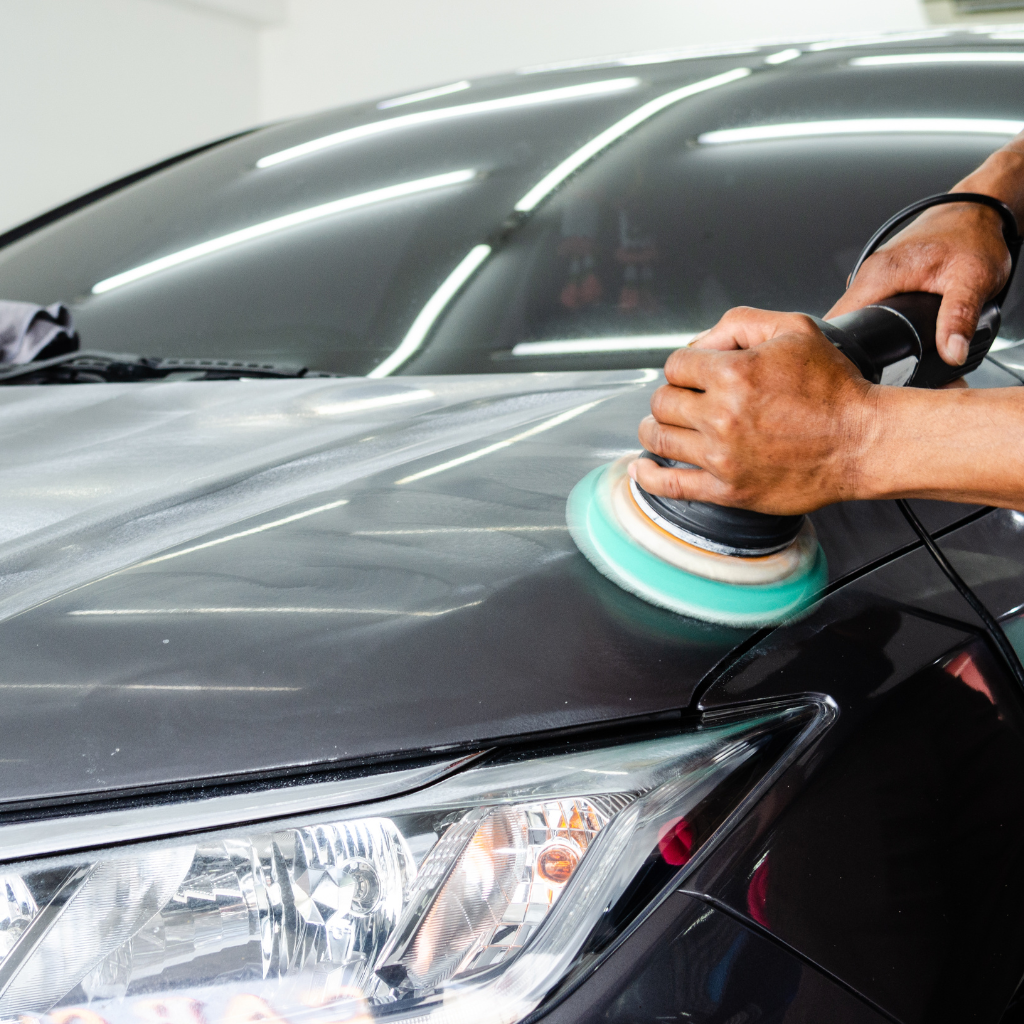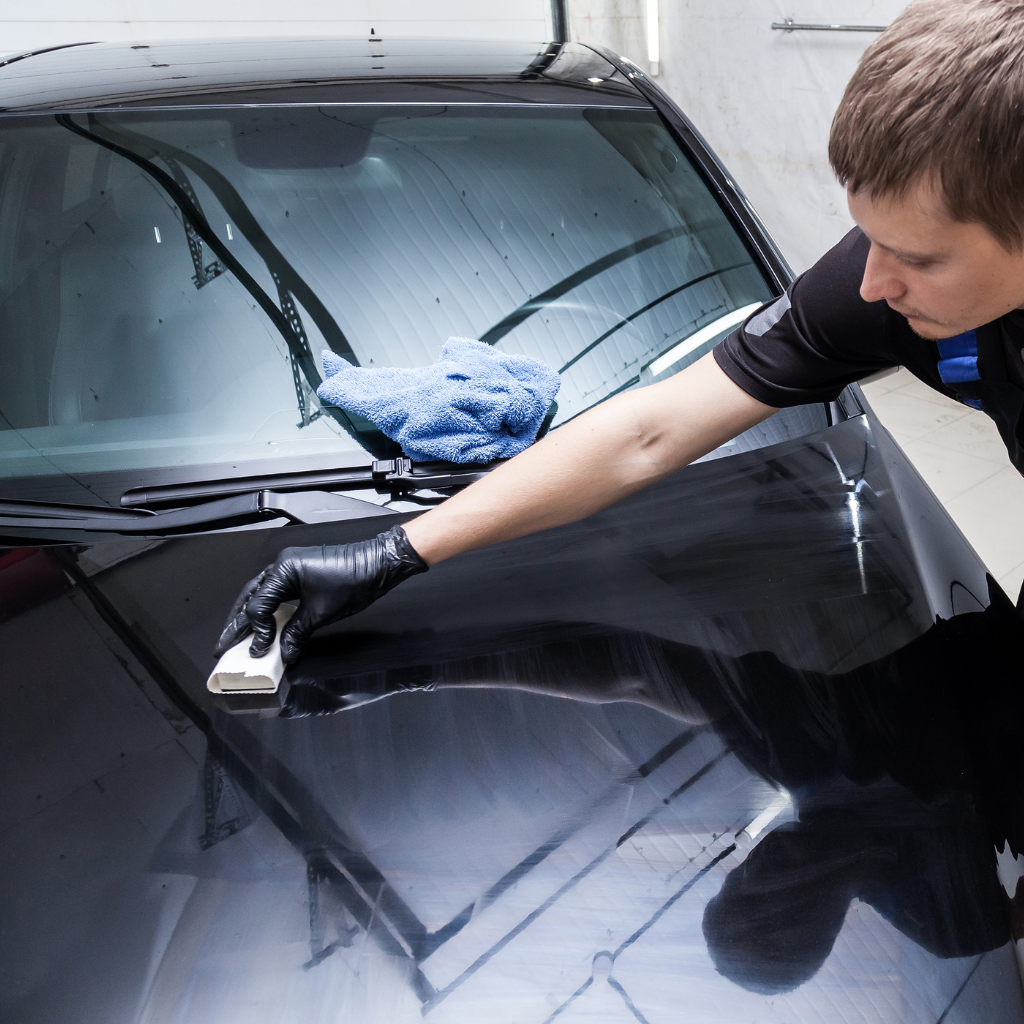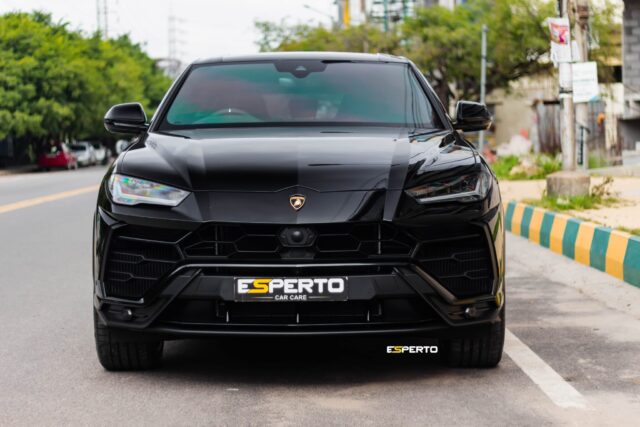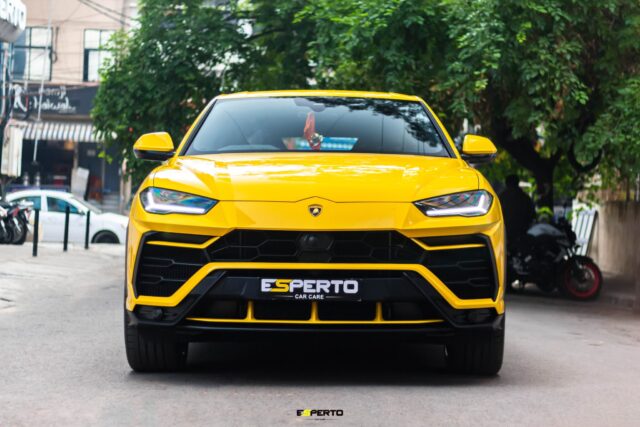Car coatings, including ceramic, wax, and Paint Protection Films (PPF), provide varying benefits tailored to the specific needs of different vehicles. Ceramic coatings offer durability and UV protection, wax coatings enhance shine and require frequent application, and PPFs provide superior damage resistance. Each type guarantees long-term preservation of aesthetic and structural integrity. To best protect your vehicle, choosing the right type of coating based on its exposure and maintenance capability is vital, with further exploration revealing more in-depth insights on ideal utilization.
Key Takeaways
- Ceramic coatings offer long-lasting protection against environmental contaminants, UV rays, and minor scratches.
- Wax coatings are cost-effective and enhance vehicle shine but require frequent reapplication.
- Paint Protection Films provide robust protection against physical damages like rock chips and are durable for 5-10 years.
- Teflon coatings simplify cleaning due to their non-stick properties, aiding in maintaining a clean exterior.
- Regular maintenance of coatings, such as bi-weekly washes, extends their lifespan and preserves vehicle aesthetics.
What Are the Car Coatings Types?
Various types of car coatings, including other coatings, offer distinct protective benefits and challenges.
Prefer Ceramic coatings provide a durable barrier against environmental contaminants and UV rays, enhancing a vehicle’s gloss and preservation of the original paintwork.
Conversely, wax coatings, while offering a cost-effective shine and protection, may require more frequent applications compared to the long-lasting protection offered by Paint Protection Films (PPF), which are best suited for high-impact areas prone to scratches and chips.
How does ceramic coating protect a car?
While ceramic coatings offer a range of benefits, their primary function is to provide a robust layer of protection for a car’s paint. Ceramic coatings form a hard, protective barrier that defends the vehicle’s paint from various damaging elements. This superior protection extends to resisting scratches, chemicals, and even UV rays, which can fade and degrade the paint over time.
| Feature | Benefit |
|---|---|
| Scratch Resistance | Reduces incidence of superficial damage |
| Chemical Barrier | Shields paint from harmful contaminants |
| UV Protection | Protects against paint fading |
| Durability | Extends the life of the vehicle’s paint |
What are the pros and cons of wax coating
Wax coating, a traditional option among car coating types, offers a layer of protection that enhances the vehicle’s surface with a high gloss finish. This type of paint protection requires meticulous surface preparation but is generally easier to apply than more advanced coatings, especially under high temperatures.
It contributes to the preservation of the paint job by providing a barrier against environmental contaminants and UV rays. Regular washing and reapplication are necessary, as the protection it offers is less durable than alternatives like ceramic coatings.
Nonetheless, the wax coating remains a popular choice for those seeking a cost-effective solution with added protection and aesthetic enhancement of their car’s appearance.

When is paint protection film (PPF) the best choice
When considering the ideal car coating for maximum durability and damage resistance, paint protection film (PPF) often emerges as the superior choice. Designed to fend off rock chips, minor scratches, and environmental contaminants, PPF offers a notable protection level for a vehicle’s paint. This clear, thermoplastic urethane film bonds directly to the paint surface, forming a robust barrier that maintains the integrity of the car’s paintwork.
Here’s a quick comparison of PPF to other protective coatings for cars:
| Feature | Paint Protection Film (PPF) |
|---|---|
| Damage Resistance | High |
| Visibility | Clear, virtually invisible |
| Longevity | 5-10 years |
| Application Complexity | Professional preferred |
| Cost | Higher initial investment |
PPF provides complete protection without altering the appearance of the clear coat, making it an ideal choice for maintaining pristine car aesthetics.
How to Apply Ceramic Coating Effectively?
Effective application of ceramic coating begins with meticulous preparation of the car’s paint, guaranteeing it is free from contaminants and imperfections.
This process involves thorough cleaning, decontamination, and possibly polishing the surface to achieve an ideal bonding environment.
Following preparation, the coating application must be executed systematically, adhering to manufacturer-specific guidelines to guarantee uniform coverage and ideal curing conditions.
How should you prepare a car’s paint before applying a protective coating
Proper preparation of a car’s paint is essential before applying a ceramic coating to guarantee ideal adhesion and performance.
The preparation process involves several critical steps to verify the surface of the car exterior is primed for the application of protective coatings.
- Thorough Cleaning: Remove all dirt, grime, and residues from the car’s paint using a high-quality automotive cleanser.
- Removal Process: Eliminate any contaminants like tar, sap, or iron filings with a clay bar, enhancing the smoothness of the paint surface.
- Surface Inspection and Treatment: Inspect the paint for any scratches or imperfections and treat them accordingly to verify a flawless base for the paint protection coating.
These steps form the foundation for a successful and durable paint coating application.
What are the steps for applying a car coating?
Applying a ceramic coating to a car requires meticulous attention to detail to guarantee excellent protection and longevity of the vehicle’s exterior.
The ceramic coating application begins with ensuring the car paint is clean and free of any contaminants. Once prepped, the best ceramic coating is carefully applied to form a uniform layer on the car. This layer is essential as the primary function of the car coating is to protect the paint from environmental damage.
Applied correctly, the DIY ceramic coating should be allowed a sufficient curing time, which varies by product. This curing process is critical for the coating to bond effectively with the car paint, enhancing durability and efficacy in shielding the vehicle’s surface.
Professional application is recommended for best results.
How to Maintain Your Car After a Protective Coating
Once a protective ceramic coating is applied to a vehicle, maintaining its integrity and appearance requires specific care practices.
Proper care is vital to maximize the long-term protection that ceramic coatings provide against environmental hazards. Here are some recommended practices:
- Regular Cleaning: Keep the car clean by washing it bi-weekly to prevent dirt and grime from accumulating, which can degrade the ceramic coating.
- Avoid Harsh Chemicals: Use pH-neutral cleaning agents to guarantee the smooth finish of the coating isn’t compromised.
- Immediate Removal of Contaminants: Promptly remove bird droppings, tree sap, and other acidic contaminants to prevent them from etching the coating.
These steps help maintain the efficacy of coatings on the market, ensuring the vehicle retains its aesthetic appeal.
What Are the Benefits of Car Coatings?
Car coatings serve as a robust barrier against environmental elements such as UV rays, salt, and pollution, greatly reducing the potential for oxidation and corrosion on the vehicle’s surface.
By enhancing the car’s exterior appearance, these coatings provide a high-gloss finish that sustains the vehicle’s aesthetic appeal over time.
Additionally, the application of car coatings offers long-term paint protection, thereby extending the lifespan of the vehicle’s paintwork by preventing fading and wear from regular exposure to harsh conditions.
Protection Against Environmental Elements
To shield vehicles from the harsh effects of environmental elements, specialized car coatings serve as an essential protective barrier.
These coatings are designed to offer a durable layer of protection that effectively counters a variety of damaging factors. Here are some key benefits:
- Corrosion Prevention: Coatings protect the metal parts of a car from rust and corrosion caused by moisture and salt.
- UV Damage Resistance: A quality car coating minimizes the harmful effects of the sun’s UV rays, thereby preventing the fading and degradation of the car’s exterior paint.
- Repelling Water and Other Contaminants: Advanced formulations help to repel water, acid rain, and other contaminants, guaranteeing the vehicle remains clean and reducing the frequency of washes needed.
These features guarantee long-lasting preservation of the vehicle’s integrity and aesthetics.
Enhancing the Car’s Exterior Appearance
While protecting against environmental damage, car coatings also greatly enhance the vehicle’s exterior appearance. Ceramic coatings offer a glossy finish that not only keeps the car looking new but also adds a vibrant, attractive sheen to the paint. This glossy layer is not just about aesthetics; it makes the vehicle stand out with a showroom quality that lasts. Additionally, ceramic paint helps maintain the integrity of the car’s exterior, ensuring that the colors remain bright and unaffected by UV rays or harsh weather conditions. DIY ceramic solutions are available, allowing car enthusiasts to apply these coatings themselves, ensuring they can personally protect a car’s paint while enhancing its appearance.
| Feature | Benefit | Application |
|---|---|---|
| Glossy Finish | Enhances vibrancy and shine of the paint | DIY or professional |
| Ceramic Paint | Protects color integrity and brightness | DIY or professional |
| Coatings | Adds a protective layer over the paint | DIY or professional |
| Durability | Extends the life of the exterior surface | DIY or professional |
Long-term Paint Protection
Most vehicle owners recognize the importance of maintaining their car’s aesthetic appeal, but the benefits of car coatings extend greatly into long-term paint protection.
Coating products are designed to shield the vehicle’s paint from environmental hazards and wear, ensuring the car retains its value and pristine look.
Here are the key advantages of using protective coatings:
- Barrier Against Elements: The coating acts as a barrier, protecting the car’s exterior from UV rays, acid rain, and road salt.
- Scratch Resistance: Different types of coatings add a tough layer that helps minimize scratches and scuffs.
- Ease of Maintenance: With a thin coating applied, dirt and grime adhere less, making the vehicle easier to clean and maintain.
How to Choose the Best Coating for Your Car?
Selecting the ideal coating for a vehicle involves a thorough understanding of the various types of protective coatings available.
Factors such as environmental exposure, vehicle usage, and aesthetic preferences greatly influence the choice of coating.
It is crucial to evaluate key features in ceramic coatings, including durability, ease of application, and maintenance requirements, to guarantee long-term protection and gloss retention.
Understanding Different Types of Protective Coatings
When considering protective coatings for vehicles, it is essential to understand the various types available, each designed with specific functionalities to enhance and protect the car’s exterior.
Here are some notable options:
- Ceramic Coatings: Preferred for their durability and ability to shield the car from scratches. These coatings also demand specific maintenance routines.
- Teflon Coating: Known for its non-stick properties, it offers resistance against dirt and grime, facilitating easier cleaning.
- Vinyl Wraps: While not a traditional coating, vinyl wraps provide a reversible option for color and design changes, protecting the original paint underneath.
Choosing the right ceramic coating or other types of protective coatings involves considering these unique benefits, ensuring the selected coating protects the car effectively and meets the owner’s needs.
Factors Influencing Coating Choice
Understanding the different types of protective coatings sets the stage for the next step: evaluating various factors to determine the best choice for a vehicle’s needs.
When choosing the right car coating, consider the environment: extreme heat demands a durable, heat-resistance option like ceramic coatings. Economic factors also play a vital role; while ceramic might offer superior protection, its higher cost may not suit every budget, making more economical options appealing.
Additionally, car enthusiasts interested in DIY coating options should seek PH-neutral products to guarantee safety and effectiveness during paint correction.
The benefits of car coatings are manifold, but aligning them with individual needs and circumstances, whether it’s for durability, cost, or ease of application, is key to making an informed decision.
Essential Features to Consider in a Ceramic Coating
As vehicle owners navigate the myriad options for car coatings, identifying key features in ceramic coatings can greatly enhance their decision-making process.
Ceramic coatings are known for their superior protection and durability, which makes them one of the best choices for preserving a vehicle’s appearance.
When selecting a ceramic coating, consider these critical aspects:
- Longevity and Durability: Choose a coating that offers extended protection against environmental elements and frequent car washes.
- Ease of Maintenance: Look for coatings that make the car easier to clean and maintain, keeping your car looking newer for longer.
- Finish Quality: Opt for a high-quality finish that not only protects but also enhances the vehicle’s aesthetic appeal, ensuring the best results.
Is DIY Coating a Viable Option?
Considering the application of DIY ceramic coatings, vehicle owners weigh the pros and cons to determine its feasibility.
Vital tools and materials are required for proper application, ensuring the coating’s longevity and effectiveness.
Additionally, understanding and avoiding common mistakes is key to achieving a professional-grade finish without the expense of a professional service.

Essential Tools and Materials Needed
To undertake a DIY ceramic coating project, car enthusiasts must first gather the appropriate tools and materials. Essential items include a high-quality ceramic coating product suitable for many types of car surfaces, microfiber towels for application, and a detailing spray to aid in the removal of any residual particles before the coating process.
Additionally, having a well-lit workspace and wearing protective gloves are essential to guarantee precision and safety. For every car, it’s important to choose a ceramic coating that matches the specific paint type and condition, as this impacts the outcome.
Applicators, usually foam pads, are necessary to evenly distribute the coating evenly, guaranteeing a uniform layer that adheres properly to the car’s exterior.
Common DIY Ceramic Coating Mistakes to Avoid
Many DIY enthusiasts are tempted to apply ceramic coatings themselves to save on costs, but common pitfalls can compromise the effectiveness and durability of the coating.
When undertaking a DIY ceramic coating application, several vital errors should be meticulously avoided:
- Inadequate Surface Preparation: Proper cleaning and decontamination of the car’s surface are vital. Residual dirt or oils can prevent the coating from bonding correctly.
- Incorrect Application Methods: Using the wrong tools or techniques can lead to uneven coverage, which may result in streaks or low gloss levels.
- Ignoring Cure Times: Ceramic coatings need sufficient time to cure; rushing this process can diminish the coating’s protective properties and longevity.
Conclusion
To sum up, selecting the appropriate car coating involves understanding the various types available and their specific benefits. Effective application—whether professionally done or DIY—enhances a vehicle’s aesthetic and protective qualities. Ceramic coatings, for instance, offer superior durability and finish. Car owners should weigh factors such as climate, vehicle usage, and personal preferences to make an informed choice. Ultimately, the right coating not only preserves the car’s appearance but also contributes to its longevity and value.






